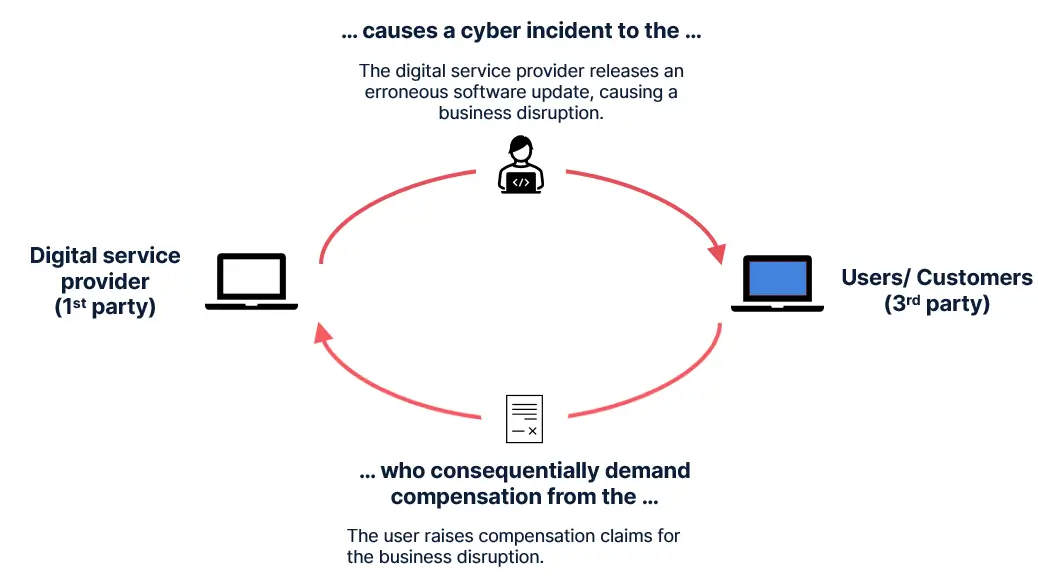Why Digital Liability Matters Now
Digital transformation has shifted from being a strategic initiative to a core business reality. Across industries, organizations are digitizing products and services. From cloud-based services and SaaS offerings to software-driven products, digital delivery has become a primary value driver and in many cases, a contractual obligation.
But with this shift comes a new form of exposure: digital liability. While boards and executives are well-versed in cyber threats such as ransomware or data breaches, far fewer have digital liability on their radar. Yet the financial and reputational consequences of failing to deliver technology as promised can be equally severe, especially in cases of underestimating gross negligence
What is Digital Liability?
Digital Liability refers to the third-party risk of financial loss that arises when a company fails to deliver its technology products or services as contracted. Unlike data breaches, which primarily involve security failures, digital liability focuses on errors, delays, or system breakdowns in technology delivery.
Digital liability can arise from various human mistakes, malicious threat actors, programming flaws, or infrastructure failures that disrupt third-party operations and have direct contractual and legal implications, including:
- Damaged data: Loss or corruption of client data during processing or migration.
- Software failures: Bugs, coding errors, or security gaps in delivered software.
- System failures: Hardware or software malfunctions affecting third-party service continuity.
- Human error: Misconfigurations or incorrect advice impacting client systems.
- Poor advice: Inadequate consulting or guidance provided to clients.
Digital Liability - an example
Consider a cloud migration project. If a consultancy or service provider delivers late, mismanages the process, or chooses the wrong approach, the client’s operations may be disrupted. This contractual breach can result in claims for damages, often across multiple customers simultaneously.
The most prominent recent real-life example of a digital liability incident was the Crowdstrike outage, that caused disruptions in systems around the world. While the contractual liability was manageable, one claimant's lawsuit for gross negligence exceeded the contractual liability costs by eight times reaching $ 500M .
Further incidents are known - an erroneous software at a trading company caused a mistakenly billion-high purchase of stocks. In another case, a consulting firm caused a breach of contract when it failed to deliver a computer system.

Why Digital Liability is Relevant for Companies
The relevance of digital liability extends beyond the software developing industry. For boards and C-levels across all industries, the exposure carries significant implications:
Emerging Risk Across Industries - Every company delivering digital services is exposed, whether in healthcare, finance, manufacturing, or logistics. The more digitalized products and services become, the higher the liability if delivery fails.
Accumulation Risk - Failures rarely affect just one client. A single outage or error can cascade across hundreds or thousands of customers. The CrowdStrike outage in 2024 illustrated how a single software issue disrupted businesses worldwide.
Gross Negligence - While often underestimated or overlooked, proven gross negligence causes contractual limitations to become void. Companies then face full tort liability, with damages far exceeding standard liability caps, which the Crowdstrike incident revealed recently.
Unlike traditional cyber risks, digital liability is less visible and mostly does not appear in breach headlines. This makes it easy to underestimate until losses materialize.
Who Should Care?
Digital liability concerns any business providing digital products or services to third parties. Any company working also partially in one of the following segments can be affected. Key examples include:
- Technology Manufacturers: Delivering hardware or software to clients.
- IT Service Providers: Managing infrastructure, consulting, or cloud services.
- Software Developers: Building applications or software solutions.
- Consultancies: Guiding clients through digital transformations.
Especially for companies, entering the digital realm or only partially producing within one of these segments, the risk is not yet visible or underestimated. A central awareness point for boards is therefore identifying to what degree digital products and services affect your company’s risk profile.
What Can Companies Do?
Awareness is the first step. Boards should ensure management recognizes digital liability as a distinct exposure category. From there, companies can take two strategic actions:
- Risk Mitigation
- Implement stronger quality assurance, software development and project management processes.
- Increase transparency in client contracts, particularly around liability caps.
- Regularly assess critical dependencies in technology delivery.
- Risk Transfer
- Traditional cyber insurance may cover digital liability to a certain extent.
- Specialized Tech Errors & Omissions (E&O) insurance can provide financial protection against contractual liability claims.
Conclusion: A Blind Spot That Needs Attention
As many companies are moving towards digitalizing products and services, Digital liability has turned from a distant or abstract risk to an imminent risk of direct financial consequence. Especially in cases of gross negligence claims, costs can drastically exceed any contractual liability limitation. As more services move to the cloud, integrate with customer operations, and rely on complex interconnections, the probability and impact of failure increase.
For executives and board members, the responsibility is clear:
- Recognize digital liability as an emerging risk.
- Integrate it into enterprise risk management.
- Consider both mitigation and transfer strategies.
Ignoring digital liability today could leave organizations unprepared for tomorrow’s claims. Addressing it now provides resilience, safeguards reputation, and ensures business continuity.









